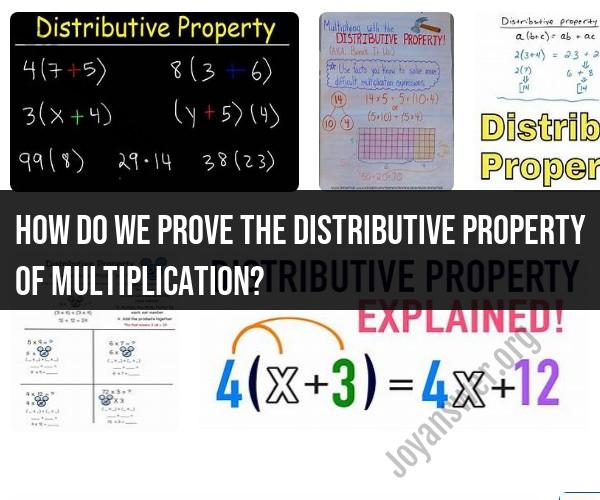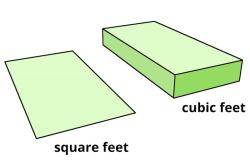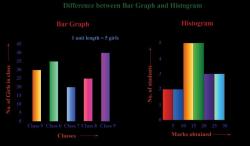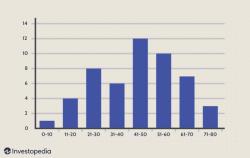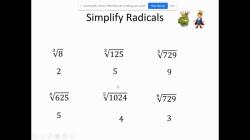How do we prove the distributive property of multiplication?
The distributive property of multiplication over addition is a fundamental property in mathematics, and it states that for any numbers a, b, and c:
a * (b + c) = (a * b) + (a * c)
In other words, you can distribute the multiplication operation over the addition operation. To prove this property, you can use a method called proof by contradiction or direct proof. Here, I'll explain the direct proof method:
Direct Proof of the Distributive Property:
Start with the Expression: Begin with the left-hand side (LHS) of the distributive property: a * (b + c).
Apply the Definition of Multiplication: Recognize that a * (b + c) means adding b to itself c times, which is equivalent to a * b + a * c.
Create an Equality: Now, you have transformed the LHS into a * b + a * c. Your goal is to show that this is equal to the right-hand side (RHS) of the distributive property, which is (a * b) + (a * c).
Start with the RHS: Begin with the RHS: (a * b) + (a * c).
Simplify the RHS: You can see that (a * b) + (a * c) is already in a simplified form.
Show Equality: Now, by showing that the LHS (a * b + a * c) is equal to the RHS ((a * b) + (a * c)), you have successfully proved the distributive property of multiplication over addition.
Here is a summary of the proof:
LHS: a * (b + c)= a * b + a * c (using the definition of multiplication)
RHS: (a * b) + (a * c)
Since LHS = a * b + a * c and RHS = (a * b) + (a * c), you have proven the distributive property.
This direct proof method demonstrates that the distributive property is valid for all real numbers a, b, and c. It's important to note that this property is a fundamental aspect of arithmetic and algebra, and it's widely accepted as a basic rule in mathematics.
How is the distributive property of multiplication proven in mathematics?
There are many different ways to prove the distributive property of multiplication, depending on the level of rigor and the audience. One common approach is to use mathematical induction.
Mathematical induction is a proof technique that is used to prove statements that hold for all natural numbers. It works by proving two things:
- The statement holds for the base case (usually 0 or 1).
- If the statement holds for some natural number , then it also holds for the next natural number .
To prove the distributive property of multiplication using mathematical induction, we can use the following steps:
- Base case: Let , , and be natural numbers, and let . Then:
a \times (b + 0) = a \times b + a \times 0
= ab + 0
= ab
- Inductive step: Assume that the distributive property of multiplication holds for some natural number , i.e.:
a \times (b + n) = ab + an
Then, we need to show that it also holds for the next natural number, . We can do this as follows:
a \times (b + (n + 1))
= a \times (b + n + 1)
= a \times ((b + n) + 1)
= (a \times (b + n)) + (a \times 1)
= (ab + an) + a
= ab + an + a
= a(b + n + 1)
Therefore, the distributive property of multiplication holds for all natural numbers.
What are the mathematical proofs and demonstrations of the distributive property?
In addition to the proof by mathematical induction given above, there are many other ways to prove the distributive property of multiplication. Some other common approaches include:
- Set theory: The distributive property of multiplication can be proven using the following set theory identity:
A \times (B \cup C) = (A \times B) \cup (A \times C)
- Algebraic reasoning: The distributive property of multiplication can also be proven using algebraic reasoning. For example, we can start by rewriting the distributive property equation as follows:
a \times (b + c) = ab + ac
=> a \times (b + c) - ab = ac
=> a \times (c - b) = ac - ab
We can then see that this equation holds for any values of , , and .
Can you explain the logical and algebraic reasoning behind the distributive property?
The logical reasoning behind the distributive property is that it is a way of distributing a quantity over a sum. In other words, it allows us to break down a multiplication problem into smaller, more manageable parts.
The algebraic reasoning behind the distributive property is that it is a consequence of the definition of multiplication. Multiplication is defined as repeated addition, so the distributive property is simply a way of rewriting repeated addition in a more concise way.
How to teach and convey the proof of the distributive property to students?
One way to teach and convey the proof of the distributive property to students is to use a visual representation. For example, we can use a rectangular area to represent the product of two numbers. The length of the rectangle represents the first number, and the width of the rectangle represents the second number. The area of the rectangle represents the product of the two numbers.
To prove the distributive property, we can divide the rectangle into two smaller rectangles, one for each addend in the sum. The sum of the areas of the two smaller rectangles will be equal to the area of the original rectangle. This is a visual representation of the following equation:
a \times (b + c) = ab + ac
Another way to teach the distributive property is to use concrete examples. For example, we can ask students to imagine that they have 10 candies and they want to divide them equally among 3 friends. We can then show them how to use the distributive property to solve this problem.
How to deepen your own understanding of the distributive property through proofs and exercises?
One way to deepen your own understanding of the distributive property is to try to prove it yourself. This is a good way to understand the logical and algebraic reasoning behind the property.
Another way to deepen your understanding of the distributive property
